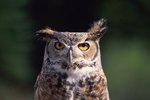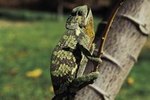
Just like humans, geckos need a good night’s -- or day’s -- sleep. Geckos typically hide themselves under tree bark, in a cavity or other sheltered space when sleeping. When sleeping, those geckos who are equipped with eyelids shut them, and those without eyelids constrict their pupils as much as possible.
Differing Lifestyles
Though most geckos are nocturnal, some are diurnal: active during daylight hours. Nocturnal species typically have elliptical pupils like cats', while diurnal species tend to have round pupils. Long thought to be adaptations for seeing better in low light, recent research has cast doubt on this assumption. In 2010, noted herpetologist Richard Shine examined the literature regarding vertical pupils in a variety of snakes and found that hunting style rather than activity period, was more influential in determining pupil shape. In the paper, published in the “Journal of Evolutionary Biology,” Shine comments that this tendency is likely to be at work in other animals as well. So, while it is true that most nocturnal geckos have vertically elliptical pupils, it may be an adaptation to their ambush hunting style rather than for seeing in the dark.
Geckos With Eyelids
Geckos of the subfamily Eublepharidae have working eyelids. A small subfamily of only 18 described species; these lizards nonetheless have nearly global distribution. Some researchers contend this is evidence that these lizards used to be represented by many more species. In addition to the lack of eyelids, Eublepharids all share another common trait: the lack of adhesive lamellae on their toes. Accordingly, these lizards are ground dwellers, though some species can climb rough rocks and bark. Leopard geckos (Eublepharis macularius), banded geckos (Coleonyx sp.) and fat-tailed geckos (Hemitheconyx caudicinctus) are examples of geckos with eye lids.
Geckos Without Eyelids
Most living geckos do not possess eyelids; they feature a clear scale that covers the eye much like the spectacles on snakes' eyes. This group includes most of the nearly 1,500 described gecko species though they are broken up into a number of subfamilies. The eyes of these geckos are frequently marked with cryptic colors that allow the lizards to better camouflage themselves within their surroundings to avoid predators. Well-known species that lack eyelids include tokay geckos (Gekko gecko), day geckos (Phelsuma sp.) and house geckos (Hemidactylus sp.). (Reference 2) Some species, like the satanic leaf-tailed gecko (Uroplatus phantasticus), have striking eyes in bold red, white or yellow tones.
Care of Lidless Eyes
Geckos who lack eyelids have a clear scale covering each eye. While this scale gets shed like the rest of the lizard’s external scales, the eye scale must be kept clean so the lizard’s vision does not become impaired. To facilitate this, geckos use their long, sticky tongues to remove debris from the eye.
References
Photo Credits
-
Ryan McVay/Photodisc/Getty Images




